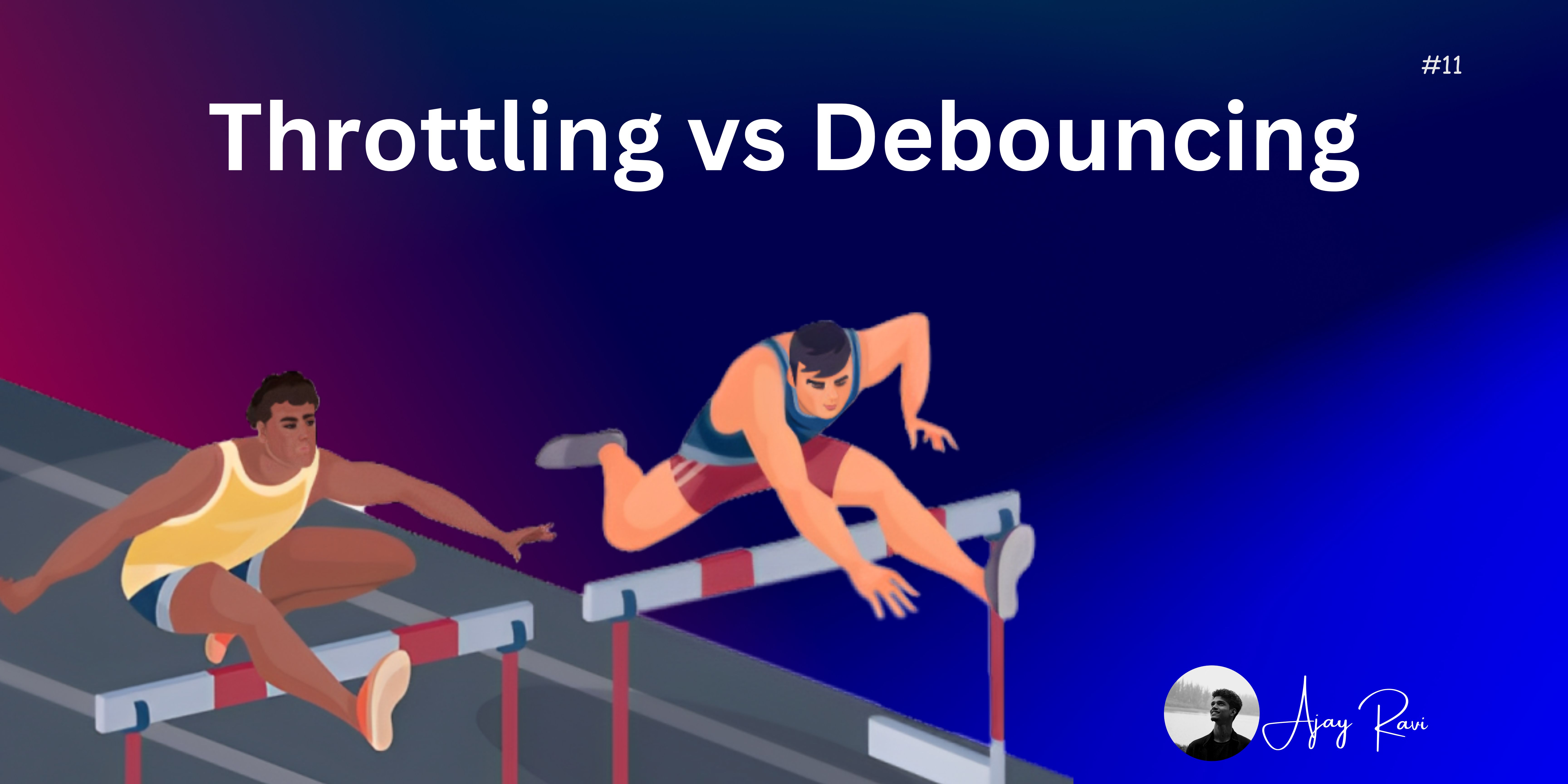Throttling vs. Debouncing: Harnessing JavaScript's Power for Optimal Performance
 Ajay Ravi
Ajay Ravi
Introduction
In the world of web applications, performance is a critical factor that can make or break the user experience. As developers, we constantly strive to optimize our applications and ensure that they run smoothly and efficiently. One common challenge we face is handling events triggered by user actions, such as button clicks, key presses, and mouse movements. These events can occur rapidly and frequently, leading to performance issues if not properly managed. Two powerful techniques that can help us address this challenge are debouncing and throttling.
Understanding the Impact of Event Listeners on Performance
Event listeners are a fundamental part of JavaScript programming, allowing us to detect and respond to changes on a web page. However, it's important to be mindful of their impact on performance. When an event listener is attached to a frequently occurring event, such as scrolling or resizing the browser window, the associated function can be called repeatedly, potentially causing unnecessary computations and slowing down the application.
For instance, let's consider a scenario where we have a function that adds new elements to the DOM every time the user scrolls. With a scroll event listener, this function will be called for every pixel the user scrolls, leading to multiple reflows and repaints. These calculations can significantly affect performance and degrade the user experience. To optimize performance, it is best practice to control how often a performant-heavy function is called.
Debounce: Delaying Function Invocation
Debouncing is a technique that allows us to control how often a function is called by delaying its invocation until a specific amount of time has passed without any new events being triggered. This is particularly useful for events that require irregular user actions, such as typing in an input field or clicking a button.
The concept of debouncing can be likened to a "wait-and-see" approach. When we debounce a function, we wait to see if the user carries out an action within a specified amount of time. If no action is detected during that time, we proceed to invoke the function. However, if a new action is triggered before the time elapses, the debounce timer is reset, and we wait again.
To implement debouncing in JavaScript, we can utilize the setTimeout and clearTimeout functions. Here's an example of a debounce function:
let debounceTimer;
const debounce = (callback, time) => {
clearTimeout(debounceTimer);
debounceTimer = setTimeout(callback, time);
};
In this code snippet, we declare a debounceTimer variable that controls the setTimeout function responsible for invoking the callback after the specified time period. Inside the debounce function, we clear the debounceTimer using clearTimeout every time the debounce function is called, ensuring that the callback function is not invoked until the time has elapsed. This approach allows us to effectively debounce an event listener and control the frequency of function calls.
Use Cases for Debouncing
Debouncing is particularly useful in scenarios where we want to reduce the number of API calls or computations triggered by user actions. For example, consider a search bar that fetches data from an API as the user types. Without debouncing, an API call would be made for every keystroke, potentially overwhelming the server and causing unnecessary network traffic. By debouncing the event listener associated with the search bar, we can limit the number of API calls to only when the user has finished typing or after a specified delay.
Throttle: Limiting Function Invocations
Throttling is another technique that helps optimize performance by limiting the number of times a function is invoked within a certain time frame. Unlike debouncing, which delays function invocation, throttling maintains a consistent interval between function calls while the event trigger is active.
Imagine throttling as a gate that opens and closes at regular intervals, allowing the passage of function invocations. When an event is triggered, the gate opens and the function is called immediately. Subsequent function calls are then scheduled at fixed intervals, preventing them from occurring too frequently.
To implement throttling in JavaScript, we can use a combination of setTimeout and a flag variable. Here's an example of a throttle function:
let shouldWait = false;
const throttle = (callback, delay) => {
return (...args) => {
if (shouldWait) return;
callback(...args);
shouldWait = true;
setTimeout(() => {
shouldWait = false;
}, delay);
};
};
In this code snippet, we declare a shouldWait variable that acts as a flag to control function invocation. Initially set to false, it prevents immediate function calls when the throttle function is first invoked. The callback is immediately called, and the shouldWait flag is set to true to prevent subsequent immediate invocations. After the specified delay, the shouldWait flag is reset, allowing the next function call to occur.
Use Cases for Throttling
Throttling is particularly useful in scenarios where continuous user events need to be managed, such as scrolling or resizing. For example, consider a gallery that dynamically loads images as the user scrolls. Without throttling, the event listener associated with scrolling could trigger multiple image loading requests in quick succession, potentially overloading the server and causing performance issues. By applying throttling to the scroll event listener, we can ensure that image loading requests occur at a controlled and manageable rate.
Debouncing vs. Throttling: Choosing the Right Technique
Both debouncing and throttling serve the purpose of optimizing performance by controlling the frequency of function invocations. However, it's important to choose the right technique based on the specific requirements of your application.
Debouncing is most suitable for events that require sporadic(irregular) user actions or input, such as typing or button clicks. It ensures that the associated function is only called after a certain period of inactivity, reducing the number of unnecessary function invocations and improving performance.
Throttling, on the other hand, is most effective for managing continuous user events, such as scrolling or resizing. By limiting the rate at which the associated function is called, throttling prevents excessive function invocations and helps maintain a smooth and responsive user experience.
When deciding between debouncing and throttling, consider the nature of the event and the desired user interaction. If the event requires immediate feedback and continuous updates, throttling may be more appropriate. However, if the event involves sporadic or infrequent actions, debouncing can help reduce unnecessary computations and improve performance.
Conclusion
Debouncing and throttling are powerful techniques that can greatly enhance the performance and responsiveness of your JavaScript applications. By controlling the frequency of function invocations, these techniques help minimize unnecessary computations, reduce network traffic, and provide a smoother user experience.
When implementing debouncing or throttling, consider the specific requirements of your application and choose the appropriate technique accordingly. Experiment with different delay values and observe the impact on performance to find the optimal configuration.
Remember, performance optimization is a continuous process, and debouncing and throttling are just two tools in your arsenal. Keep exploring other strategies and best practices to further enhance the performance of your web applications and deliver an exceptional user experience.
So, the next time you're faced with a situation where frequent event triggers threaten performance, remember to employ debouncing or throttling to keep your application running smoothly and efficiently.
Subscribe to my newsletter
Read articles from Ajay Ravi directly inside your inbox. Subscribe to the newsletter, and don't miss out.
Written by

Ajay Ravi
Ajay Ravi
Unleashing Web Development Superpowers while Diving into the Exciting Realms of Blockchain and DevOps